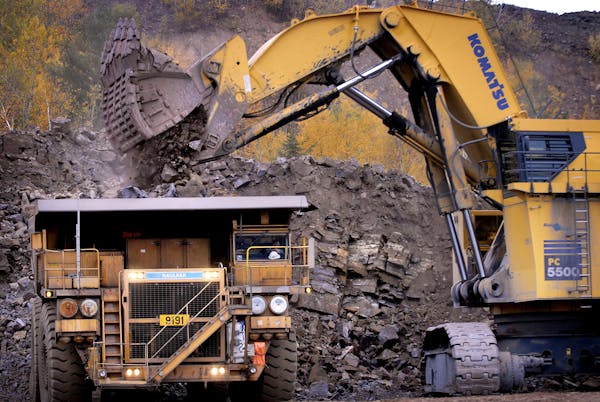A tiny Canadian company is hoping Minnesota's Iron Range could be the next source of a globally sought-after element - helium.
Far from simply giving lift to balloons, the noble gas has become an essential ingredient in space exploration, semiconductor chip manufacturing and some medical imaging. Large pockets are rare, but by chance, drillers looking for platinum and palladium stumbled on what might be a major reservoir locked more than 1,700 feet underground near Babbitt.
That discovery in 2011 made the region part of a global hunt for the gas, which is becoming more expensive as U.S. supplies dwindle. The British Columbia-based company Pulsar Helium started its own drilling in the same area this month in an effort to see if the chance finding can turn into a viable business.
"We came in and thought, 'Well that looks magnificent,' " said Tom Abraham-James, Pulsar's CEO.
A surprise find
Helium, the buoyant and inert gas, has some qualities that make it uniquely useful. It's a liquid at incredibly low temperatures, allowing it to supercool magnets in MRI machines, according to the Radiological Society of North America. It aids manufacturing of semiconductor chips that power modern technology. It's also a critical component of space exploration, keeping cooled liquid fuels and hot gases separate inside a rocket.
But some industry groups, like the Compressed Gas Association (CGA), worry the U.S. supply of the finite gas is flagging. The federal government is selling off its Federal Helium Reserve System, which sprawls across Texas, Oklahoma and Kansas and supplies 20% of the U.S. market. The CGA warned in a letter last month that the sale "could lead to severe disruptions in the U.S. helium supply chain."
Abraham-James said nearly all helium is a byproduct of natural gas production, but companies looking for the fossil fuel don't prioritize the lesser gas. Abraham-James does and first chased helium in Tanzania as part of a nascent industry that he said is roughly a decade old.
Most in the sector, he said, look to former natural gas fields. The discovery of the Minnesota reservoir — in a state with no natural gas production — was an accident.
Duluth Metals, once a partial owner of the Twin Metals copper-nickel project near Ely, was drilling for platinum and palladium when the team hit a pocket of pressurized gas that set off a methane alarm.
Phil Larson, a Pulsar adviser who was on the Duluth Metals team, said the gas was "absolutely screaming out of the hole."
Installing a common sampling device was an explosion risk, Larson said, but he got creative to send gas to a pair of laboratories for testing.
"I actually kind of jerry-rigged a gas sampling device out of a plastic kitchen funnel, some vinyl tubing, there was duct tape involved and there was a big 5-gallon pail full of water," Larson said.
He knew the helium concentration was promising, even though Duluth Metals sealed the drill hole and left.
Helium projects are potentially economically viable when gas extracted from the ground has 0.3% helium, Abraham-James said. What Duluth Metals found in 2011 was 10.5% helium.
"Ten-point-five percent is just madness," he said.
Why the Iron Range?
What makes Minnesota a potential helium hot spot? Ancient rocks, and a sudden rupture that disturbed them.
Peter Barry, a geochemist who has consulted on and off for Abraham-James' companies for a decade, said that in the "basement" layer of rock that forms the foundation of Earth's crust, ancient rocks contain uranium and thorium in a constant, natural state of radioactive decay. Those unstable elements break down into helium.
That helium dissolves into deep, salty groundwater, not unlike carbon dioxide dissolved into a can of soda. But in Minnesota, Barry hypothesizes, the midcontinental rift that split through the state over a billion years ago also disturbed these fluids, essentially popping the pressurized liquids and allowing the helium to fizz out. The same rift event created the Duluth Complex — a mass known for its copper and nickel deposits — which then sealed the helium gas in a plume underground.
"It's not a place where we would conventionally think about finding helium," said Barry, who completed his doctorate by studying the gas in volcano systems.
Pulsar now is drilling 50 feet from the original discovery to confirm the concentration of helium and how forcefully it flows.
At an above-ground plant roughly the size of a hockey rink, Pulsar would turn the gas into a liquid that can be trucked to customers. The company hopes to produce one 40-foot container of liquid helium per day — from one drill hole — and employ roughly 20 people if the reservoir can sustain a large operation.
Pulsar repeatedly stresses that it is pursuing helium reserves that aren't tied to fossil fuel extraction. But there is likely a small amount of natural gas in the underground reservoir it is searching.
More notably, another planet-warming greenhouse gas — carbon dioxide — comprises 73.8% of the original well sample. Abraham-James said the company plans to capture the carbon dioxide and sell it for uses like carbonating drinks.
What's next for Pulsar?
Lake County will be closely watching the project, and at minimum, Pulsar would need a permit to start a commercial operation, said administrator Matthew Huddleston.
"Certainly, there's a lot of talk and interest of what this could mean to the area and what it could mean to the country to have a potential local supply," he said.
At the state level, it's much less clear what kinds of permitting hurdles the project might have to clear. The Minnesota Department of Health oversees borehole safety to protect groundwater, and the agency has inspected the Pulsar site, a spokeswoman said.
But at the Department of Natural Resources, usually the key agency regulating mining in Minnesota, there's little to no roadmap for how a helium project would be assessed.
"We are looking at all available options for creating a clear regulatory structure for nonpetroleum gas extraction," spokesman Erik Evans wrote in an email.
Abraham-James said he expects to have results from drilling by the end of February and more information on whether the project could be viable by the end of March. "We would obviously look to fast track production" if all goes well, he said.

Minnesota Department of Health rescinds health worker layoffs

Eco-friendly house on 30 acres near Marine on St. Croix listed at $1.6M

DOGE cuts federal money for upgrades at Velveeta plant in New Ulm

